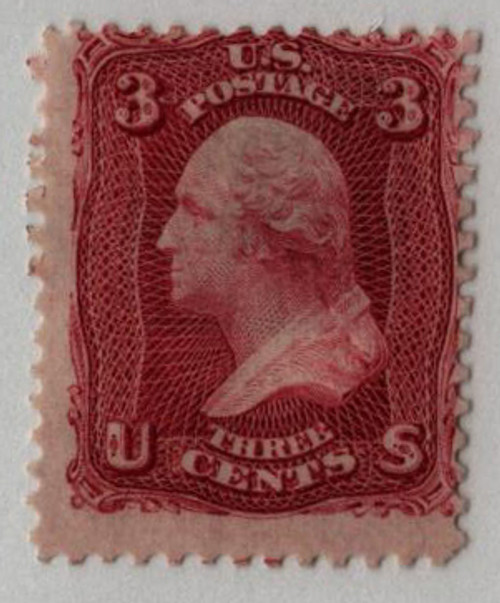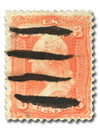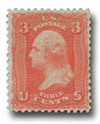
# 74TC6 - 1861 3c Scarlet, Perforated 12 on Stamp Paper
The Stamp Formerly Known as Scott #74
The subject of many philatelic debates for over a century!
Very few examples of the 3¢ Scarlet exist, often missing from even the most advanced collections! How the Scarlet came to market, its origin, and recognition as a stamp have been debated for more than a century.
The Mystery of the 3¢ Scarlet’s Origin
The first record of a 3¢ Scarlet comes from J.W. Scott – the creator of the Scott Catalogue, and author/editor of numerous philatelic publications. Scott claimed that sometime in the 1860s, he received a 3¢ Scarlet on a letter coming from a New Orleans post office. Scott wrote to the Postmaster in New Orleans and through correspondence was said to receive somewhere around four sheets of Scarlets.
Many philatelists believe that the 3¢ Scarlet is a trial color of #64 or #65 from the 1861 issue. And, some experts cast doubt on Scott’s story – as Scott didn’t begin listing it in his catalogue until the late 1870s, a decade after it’s first supposed use on the New Orleans letter. There were also no other postally known uses of the Scarlet, or even documentation of the stamp on Scott’s letter from New Orleans.
It’s much more likely Scott received trial color proofs from someone at the American Bank Note Company. For years, Scott was the only known source of 3¢ Scarlets until a new lot of them was listed for sale with four hand-penned strokes across the face…
Pen-Marked Scarlets Make Their Way to Market in the 1890s
In 1893, stamp dealer Carl Rothfuchs listed the Scarlets in his price sheet. He described them as “not postally used, but cancelled with four ink lines three quarters across the stamp. Otherwise, it is in prime condition.”
So, if the Scarlets that Rothfuchs offered weren’t for postal use, why would they have been cancelled? He later wrote in his 1910 price list the following explanation of the Scarlets:
“The 3¢ Scarlet which I offer for sale are not used, They have four ink lines three quarters across each stamp. Otherwise they are in fine condition and have original gum. All are guaranteed as genuine original 3¢ Scarlet postage stamps. And are of the same sheet that I obtained some sixteen years ago while located at Washington. I have carefully examined some of the 3¢ Scarlet sold elsewhere at private sale and by auction. Some do not compare favorable with the undoubted genuine 3¢ Scarlet.”
How did Rothfuchs get his Scarlets? It’s believed that he helped the Post Office arrange their stamp exhibit at the 1893 Columbian Exposition. In exchange for his services, the Post Office Department gave him a number of sheets of proofs. The pen-marked Scarlets most likely were in this lot. And, its likely the Post Office Department would have hand marked each stamp with pen to prevent improper postal use.
The controversy and debate over its legitimacy as a stamp has made it very desirable to even the most advanced collectors. As is common with stamps of great age, they have one or two minor imperfections that don’t detract from their collectibility. Get yours today before they’re all snapped up in permanent collections! Remember, we only have 3 in stock – time payments make it easy and enjoyable to collect this US rarity.
The Stamp Formerly Known as Scott #74
The subject of many philatelic debates for over a century!
Very few examples of the 3¢ Scarlet exist, often missing from even the most advanced collections! How the Scarlet came to market, its origin, and recognition as a stamp have been debated for more than a century.
The Mystery of the 3¢ Scarlet’s Origin
The first record of a 3¢ Scarlet comes from J.W. Scott – the creator of the Scott Catalogue, and author/editor of numerous philatelic publications. Scott claimed that sometime in the 1860s, he received a 3¢ Scarlet on a letter coming from a New Orleans post office. Scott wrote to the Postmaster in New Orleans and through correspondence was said to receive somewhere around four sheets of Scarlets.
Many philatelists believe that the 3¢ Scarlet is a trial color of #64 or #65 from the 1861 issue. And, some experts cast doubt on Scott’s story – as Scott didn’t begin listing it in his catalogue until the late 1870s, a decade after it’s first supposed use on the New Orleans letter. There were also no other postally known uses of the Scarlet, or even documentation of the stamp on Scott’s letter from New Orleans.
It’s much more likely Scott received trial color proofs from someone at the American Bank Note Company. For years, Scott was the only known source of 3¢ Scarlets until a new lot of them was listed for sale with four hand-penned strokes across the face…
Pen-Marked Scarlets Make Their Way to Market in the 1890s
In 1893, stamp dealer Carl Rothfuchs listed the Scarlets in his price sheet. He described them as “not postally used, but cancelled with four ink lines three quarters across the stamp. Otherwise, it is in prime condition.”
So, if the Scarlets that Rothfuchs offered weren’t for postal use, why would they have been cancelled? He later wrote in his 1910 price list the following explanation of the Scarlets:
“The 3¢ Scarlet which I offer for sale are not used, They have four ink lines three quarters across each stamp. Otherwise they are in fine condition and have original gum. All are guaranteed as genuine original 3¢ Scarlet postage stamps. And are of the same sheet that I obtained some sixteen years ago while located at Washington. I have carefully examined some of the 3¢ Scarlet sold elsewhere at private sale and by auction. Some do not compare favorable with the undoubted genuine 3¢ Scarlet.”
How did Rothfuchs get his Scarlets? It’s believed that he helped the Post Office arrange their stamp exhibit at the 1893 Columbian Exposition. In exchange for his services, the Post Office Department gave him a number of sheets of proofs. The pen-marked Scarlets most likely were in this lot. And, its likely the Post Office Department would have hand marked each stamp with pen to prevent improper postal use.
The controversy and debate over its legitimacy as a stamp has made it very desirable to even the most advanced collectors. As is common with stamps of great age, they have one or two minor imperfections that don’t detract from their collectibility. Get yours today before they’re all snapped up in permanent collections! Remember, we only have 3 in stock – time payments make it easy and enjoyable to collect this US rarity.













